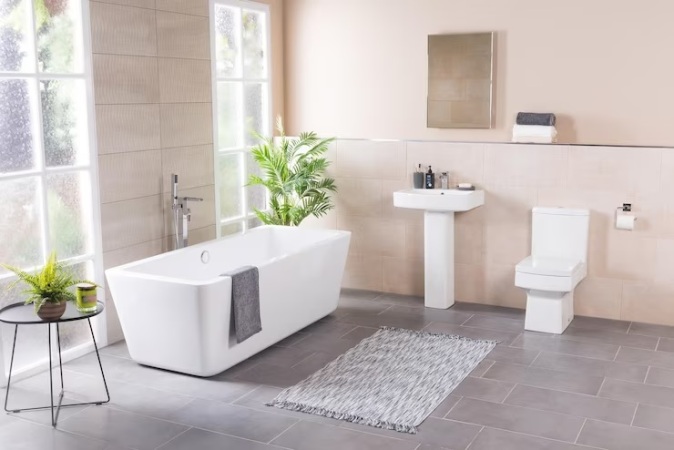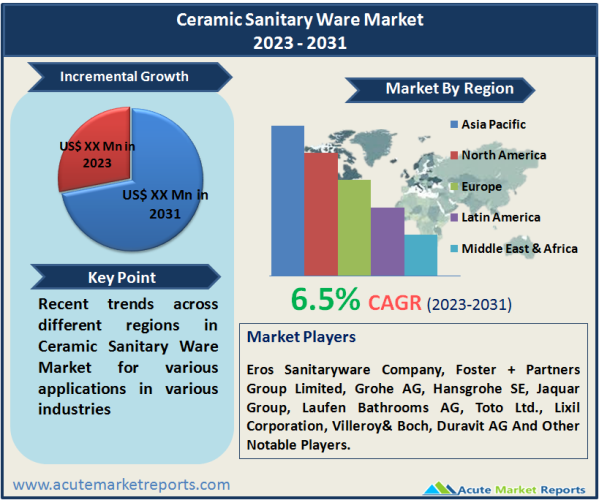
The ceramic sanitary ware market, a significant segment of the construction industry, witnessed substantial growth in 2023 and is expected to continue its upward trajectory from 2024 to 2032. This expansion can be attributed to several driving factors and innovations within the sector, along with certain challenges hindering its progress. Ceramic sanitary ware refers to ceramic bathroom fixtures and fittings that are used for sanitation purposes. These products are made from ceramic materials such as clay, kaolinite, and other minerals, which are shaped and fired at high temperatures to create durable and hygienic bathroom fixtures. Ceramic sanitary ware includes a variety of products designed for use in bathrooms and kitchens, and they are an essential part of any residential or commercial construction project.Ceramic sanitary ware market is projected to grow at a CAGR of 6.5% from 2024 to 2032, driven by urbanization, technological advancements, and increased awareness of hygiene. However, challenges related to sustainability and environmental concerns necessitate the industry's adaptation to greener practices.

Increasing Urbanization and Real Estate Development
One of the primary drivers propelling the ceramic sanitary ware market is the rapid pace of urbanization and real estate development. As urban areas expand globally, there is a growing demand for modern and aesthetically appealing sanitary ware products. Urban consumers, especially in emerging economies, are increasingly seeking stylish and functional ceramic sanitary ware items for their homes and commercial spaces. This trend has bolstered the sales of washbasins, kitchen sinks, faucets, water closets, bathtubs, bidets, urinals, and other sanitary products. Evidence supporting this trend includes the substantial rise in real estate investments, both in residential and commercial sectors, in key markets such as Asia-Pacific and Latin America.
Technological Advancements and Innovation
Technological advancements in ceramic sanitary ware production have significantly impacted market growth. Innovations in manufacturing processes, such as slip casting, spagless, jiggering, and pressure casting, have led to the development of high-quality and durable sanitary products. These advancements have not only enhanced the efficiency of production but also resulted in products with improved designs and functionality. Moreover, the integration of smart technologies in sanitary ware, including sensor-based faucets and self-cleaning toilets, has garnered substantial consumer interest. This tech-savvy approach is expected to continue driving market growth, as consumers increasingly seek convenience and efficiency in their daily lives.
Growing Awareness of Hygiene and Sanitation
The global emphasis on hygiene and sanitation, particularly in the wake of the COVID-19 pandemic, has boosted the demand for ceramic sanitary ware. Consumers are now more aware of the importance of clean and hygienic bathroom and kitchen spaces. Ceramic sanitary ware products, with their smooth surfaces and easy-to-clean properties, have gained significant traction in the market. Moreover, public awareness campaigns and initiatives by governments and non-governmental organizations to promote better sanitation practices have further accelerated the adoption of ceramic sanitary ware products. This trend is particularly notable in regions with growing populations and increasing urbanization, where the need for improved hygiene facilities is paramount.
Environmental Concerns and Sustainability Challenges
Despite the market's growth, one of the significant restraints faced by the ceramic sanitary ware industry is the increasing concern over environmental sustainability. The manufacturing process of ceramic products often involves the use of significant amounts of water and energy, leading to environmental degradation. Additionally, the disposal of old or damaged ceramic sanitary ware items poses challenges in terms of recycling and waste management. Consumers, especially in developed regions, are becoming increasingly eco-conscious, demanding sustainable and environmentally friendly products. This shift in consumer preference poses a challenge for manufacturers to innovate and adopt greener production practices. As a result, the industry is witnessing a gradual shift towards sustainable materials and energy-efficient manufacturing techniques.
Washbasin & Kitchen Sink Segment Dominates the Market by Product Type
The ceramic sanitary ware market, segmented by product type into washbasins, kitchen sinks, faucets, water closets, bathtubs, bidets, urinals, and other products, witnessed the highest CAGR and revenue generation in the washbasin and kitchen sink segment. Consumers' preference for modern kitchen and bathroom designs, coupled with the functionality of these products, contributed to their high demand. Similarly, the market segmentation by technology, including slip casting, spagless, jiggering, pressure casting, isostatic casting, and others, indicated that pressure casting technology recorded the highest CAGR and revenue. This can be attributed to the efficiency and precision offered by pressure casting techniques in manufacturing sanitary ware products.
Pressure Casting Technology Dominates the Market
Pressure casting technology, characterized by its ability to produce defect-free and detailed ceramic products, recorded the highest CAGR and revenue in the market. This technique's efficiency and precision have made it indispensable, especially for complex shapes and intricate designs. Integration of smart technologies and innovations in materials have further propelled this segment's growth.Pressure casting technology is a crucial manufacturing process in the ceramic industry, especially in the production of high-quality sanitary ware items. This method involves injecting ceramic slip (a mixture of water and clay) into a mold under high pressure. By using pressure, the slip fills the mold cavities uniformly and quickly, ensuring that there are no air bubbles or voids in the final product. The mold is typically made of plaster and absorbs excess water from the slip, aiding in the formation of a solid ceramic object. Once the ceramic material sets and hardens, the mold is opened, revealing the cast sanitary ware product.
Asia Pacific Remains as a Global Leader
Geographically, the market trends indicate a significant shift towards Asia-Pacific, with the region exhibiting both the highest CAGR and revenue percentage. The rapid urbanization, booming real estate sector, and increasing disposable income in countries like China, India, and Southeast Asian nations have led to a substantial demand for ceramic sanitary ware products. Additionally, the Middle East and Africa region demonstrated noteworthy growth due to ongoing infrastructural development projects and rising consumer preferences for high-end sanitary products.
Competitive Trends and Key Strategies
In 2023, key players in the ceramic sanitary ware market, including Eros Sanitaryware Company, Foster + Partners Group Limited, Grohe AG, Hansgrohe SE, Jaquar Group, Laufen Bathrooms AG, Toto Ltd., Lixil Corporation, Villeroy& Boch, Duravit AG, and others focused on expanding their product portfolios and enhancing their distribution networks to capture a broader consumer base. These companies invested significantly in research and development to introduce innovative and eco-friendly sanitary ware products. Furthermore, strategic collaborations and partnerships with architects, interior designers, and real estate developers were pivotal in strengthening market presence. As the market progresses from 2024 to 2032, these players are expected to continue their focus on innovation, sustainability, and customer-centric approaches to maintain their competitive edge and meet the evolving demands of consumers.
Historical & Forecast Period
This study report represents analysis of each segment from 2022 to 2032 considering 2023 as the base year. Compounded Annual Growth Rate (CAGR) for each of the respective segments estimated for the forecast period of 2024 to 2032.
The current report comprises of quantitative market estimations for each micro market for every geographical region and qualitative market analysis such as micro and macro environment analysis, market trends, competitive intelligence, segment analysis, porters five force model, top winning strategies, top investment markets, emerging trends and technological analysis, case studies, strategic conclusions and recommendations and other key market insights.
Research Methodology
The complete research study was conducted in three phases, namely: secondary research, primary research, and expert panel review. key data point that enables the estimation of Ceramic Sanitary Ware market are as follows:
Market forecast was performed through proprietary software that analyzes various qualitative and quantitative factors. Growth rate and CAGR were estimated through intensive secondary and primary research. Data triangulation across various data points provides accuracy across various analyzed market segments in the report. Application of both top down and bottom-up approach for validation of market estimation assures logical, methodical and mathematical consistency of the quantitative data.
| ATTRIBUTE | DETAILS |
|---|---|
| Research Period | 2022-2032 |
| Base Year | 2023 |
| Forecast Period | 2024-2032 |
| Historical Year | 2022 |
| Unit | USD Million |
| Segmentation | |
Product
| |
Technology
| |
Application
| |
Distribution Channel
| |
|
Region Segment (2022-2032; US$ Million)
|
Key questions answered in this report